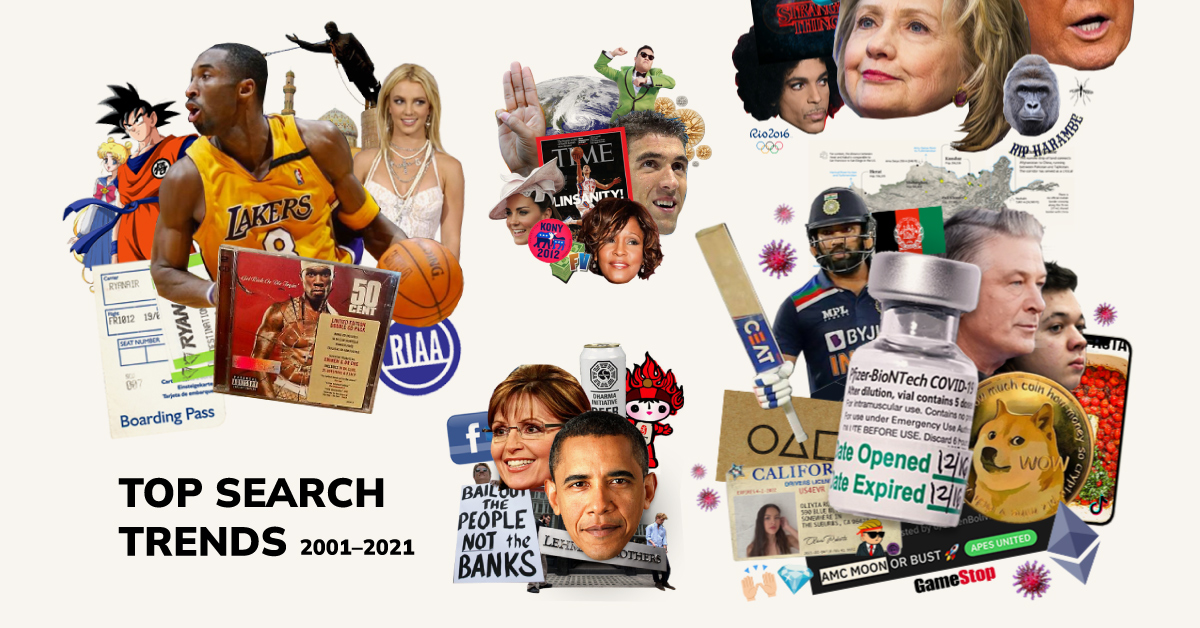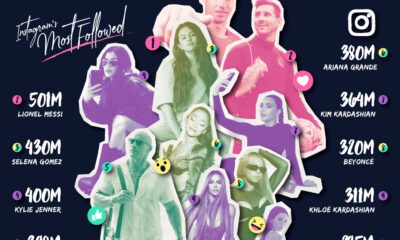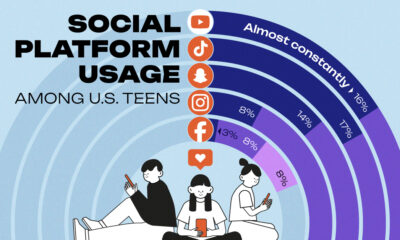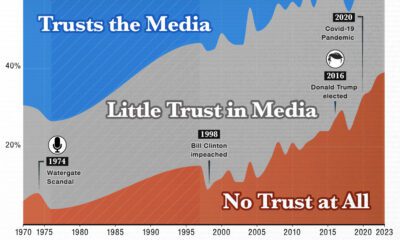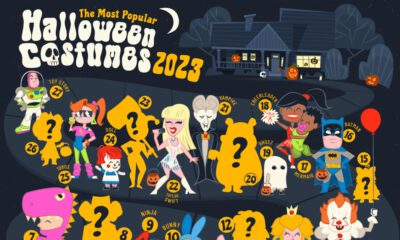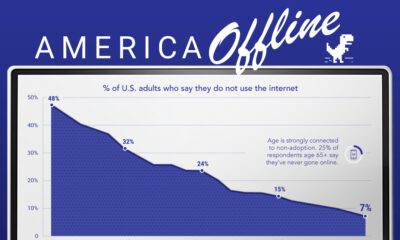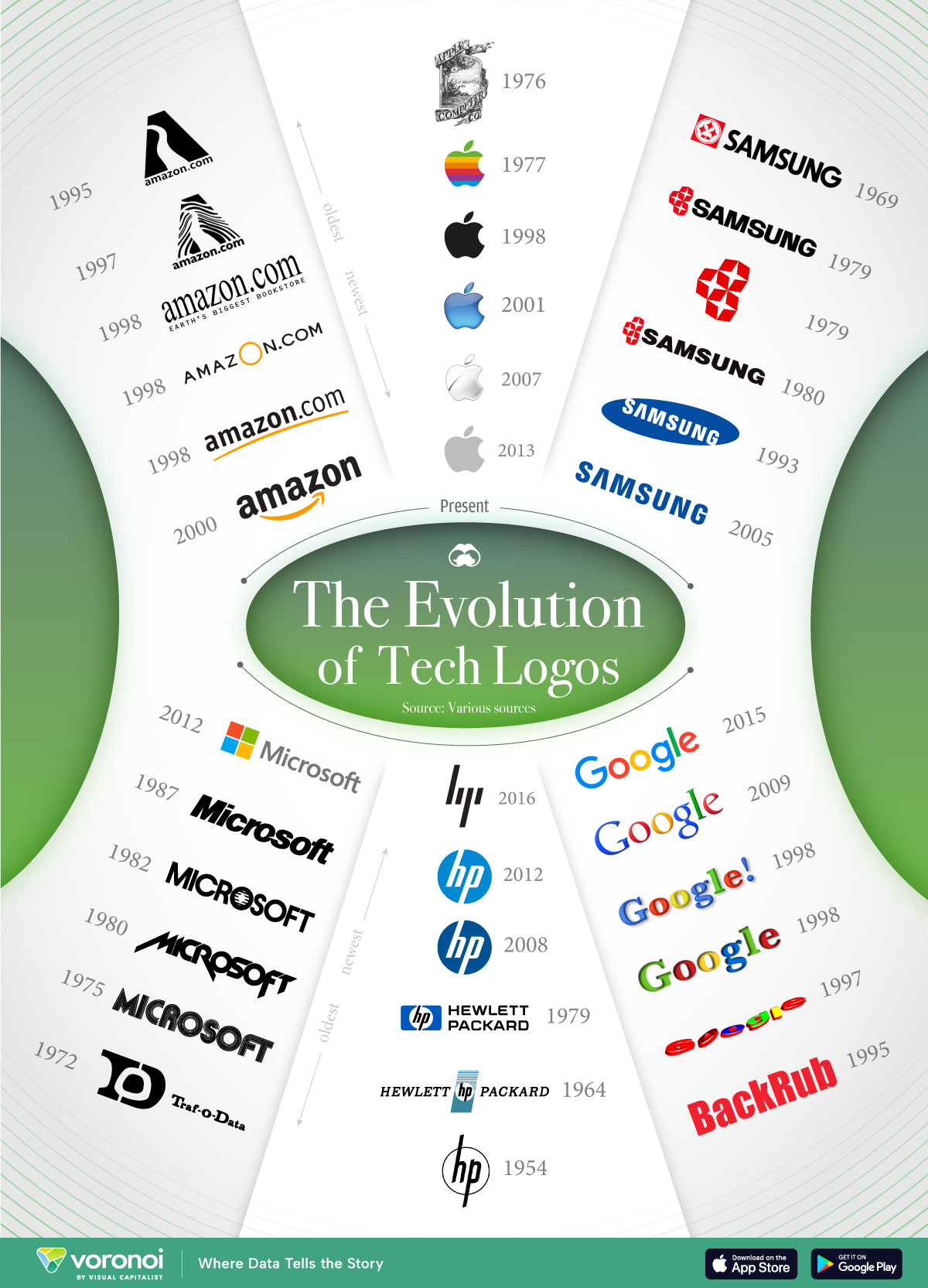Culture
20 Years of Top Trending Google Searches

20 Years of Top Trending Google Searches
For decades, Google search has been a go-to source for many when looking up directions, keeping up with the news, or seeking information on new and unfamiliar topics.
Today, Google processes about 3.5 billion searches per day. Because of its dominant market share, Google holds a vast archive of keyword searches that, when analyzed, provide an interesting glimpse into the key themes that have captured the world’s attention over the years.
This graphic, using data from Google Trends, goes back 20 years and highlights some of the top keyword searches since 2001.
Our editorial team dug through hundreds of top trending search terms from global and U.S. data and hand-selected their top picks, which are featured in the graphic above.
Trending vs. Volume
Before diving in, it’s worth emphasizing how top trending searches differ from popular searches, which are measured by sheer volume.
Trending searches are terms that have recently spiked in popularity. They focus on growth rather than total volume, and in this dataset, trending terms gauge year-over-year growth.
A good example is Donald Trump, who popped up in the news cycle during the 2016 presidential campaign. After the election, interest in Trump remained high. But his name doesn’t pop up on the Google trends list after 2017, since by that point, search volume for Trump had plateaued.
What are the most popular Google search terms, by volume? To be honest, they’re slightly less interesting than the top trending searches — YouTube is number one, followed by Facebook, then WhatsApp web.
The Globalization of Search Trends
The people and topics featured in Google’s top trends lists evolves as time goes on, reflecting broader adoption of the internet (and Google Search) around the world over time. Early themes are tied to mainstream U.S. pop culture and tech trends.
As time goes on, social media and smartphone adoption increase the granularity and volume of searches, resulting in top trends that are more participatory, diverse, and global in nature.
One final variable to keep in mind is that Google itself began to share more detailed search highlights with each passing year.
Two Decades of Google Searches: Macro Insights
Now that we’ve explained what trending searches actually measure, let’s dig into some of the key themes that have emerged over the last two decades of Google searches.
① People Love Sports
Over the last 20 years, sports have remained a continuous trend.
Every four years, the World Cup shows up as a top trending keyword across the globe. The Olympics also makes a regular appearance, along with Olympic athletes like Michael Phelps and McKayla Maroney.
Although the U.S. dominates the list, particularly when it comes to athletes, there’s still a good variety of international sports that go viral, especially as time goes on. In the last two years, cricket, rugby, and soccer have all made the top five trending lists.
② The Emergence of Celebrity 2.0
Over time, you can also see a transition from the conventional celebrity to celebrity 2.0, also known as the social media celebrity.
In the early 2000s, pop culture icons like Britney Spears, Eminem, and Jennifer Lopez flooded the trending searches, and traditional media forms like TV shows and Movies dominated the mass media categories.
But by 2011, YouTube stars like Rebecca Black started to make their way on the trending search lists. And in 2014, Meme emerged as a top trending category.
This transition nods to a larger shift in media, as digital has gradually overtaken traditional media as the dominant form of entertainment.
③ Natural Disasters are Top of Mind
Natural Disasters are a key trend throughout this data set as well.
Hurricanes are a particularly trendy word, showing up almost half the time—in eight of the 20 years. In 2005, Hurricane Katrina ranked second in the most searched category across the globe.
It continued to gain global attention—by 2006, Hurricane Katrina was still in the top five trending news searches.
Dig Deeper into Trending Google Searches
Our team enjoyed sifting through 20 years of Google data, and we hope you enjoyed this blast from the past too. If you’d like to dive deeper, you can explore Google’s full dataset here.
Happy searching.
Technology
How Tech Logos Have Evolved Over Time
From complete overhauls to more subtle tweaks, these tech logos have had quite a journey. Featuring: Google, Apple, and more.

How Tech Logos Have Evolved Over Time
This was originally posted on our Voronoi app. Download the app for free on iOS or Android and discover incredible data-driven charts from a variety of trusted sources.
One would be hard-pressed to find a company that has never changed its logo. Granted, some brands—like Rolex, IBM, and Coca-Cola—tend to just have more minimalistic updates. But other companies undergo an entire identity change, thus necessitating a full overhaul.
In this graphic, we visualized the evolution of prominent tech companies’ logos over time. All of these brands ranked highly in a Q1 2024 YouGov study of America’s most famous tech brands. The logo changes are sourced from 1000logos.net.
How Many Times Has Google Changed Its Logo?
Google and Facebook share a 98% fame rating according to YouGov. But while Facebook’s rise was captured in The Social Network (2010), Google’s history tends to be a little less lionized in popular culture.
For example, Google was initially called “Backrub” because it analyzed “back links” to understand how important a website was. Since its founding, Google has undergone eight logo changes, finally settling on its current one in 2015.
| Company | Number of Logo Changes |
|---|---|
| 8 | |
| HP | 8 |
| Amazon | 6 |
| Microsoft | 6 |
| Samsung | 6 |
| Apple | 5* |
Note: *Includes color changes. Source: 1000Logos.net
Another fun origin story is Microsoft, which started off as Traf-O-Data, a traffic counter reading company that generated reports for traffic engineers. By 1975, the company was renamed. But it wasn’t until 2012 that Microsoft put the iconic Windows logo—still the most popular desktop operating system—alongside its name.
And then there’s Samsung, which started as a grocery trading store in 1938. Its pivot to electronics started in the 1970s with black and white television sets. For 55 years, the company kept some form of stars from its first logo, until 1993, when the iconic encircled blue Samsung logo debuted.
Finally, Apple’s first logo in 1976 featured Isaac Newton reading under a tree—moments before an apple fell on his head. Two years later, the iconic bitten apple logo would be designed at Steve Jobs’ behest, and it would take another two decades for it to go monochrome.
-

 Mining1 week ago
Mining1 week agoGold vs. S&P 500: Which Has Grown More Over Five Years?
-

 Markets2 weeks ago
Markets2 weeks agoRanked: The Most Valuable Housing Markets in America
-

 Money2 weeks ago
Money2 weeks agoWhich States Have the Highest Minimum Wage in America?
-

 AI2 weeks ago
AI2 weeks agoRanked: Semiconductor Companies by Industry Revenue Share
-

 Markets2 weeks ago
Markets2 weeks agoRanked: The World’s Top Flight Routes, by Revenue
-

 Countries2 weeks ago
Countries2 weeks agoPopulation Projections: The World’s 6 Largest Countries in 2075
-

 Markets2 weeks ago
Markets2 weeks agoThe Top 10 States by Real GDP Growth in 2023
-

 Demographics2 weeks ago
Demographics2 weeks agoThe Smallest Gender Wage Gaps in OECD Countries
